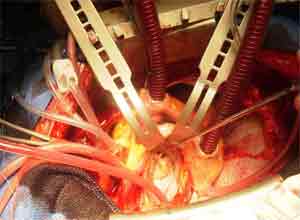Discarded surgery fat treats heart attacks
 Stem cells from fat to be discarded during cardiac surgery can improve heart function, according to research presented at Frontiers in CardioVascular Biology (FCVB) 2014 in Barcelona, Spain.
Stem cells from fat to be discarded during cardiac surgery can improve heart function, according to research presented at Frontiers in CardioVascular Biology (FCVB) 2014 in Barcelona, Spain.
Dr Ganghong Tian, senior author of the study, said: “During cardiac surgery fat tissue may need to be removed from patients to expose the heart. We were intrigued to find out whether this mediastinal fat, which would otherwise be discarded, contained stem cells that could be injected back into the heart before closing the chest. The idea was to improve heart function after a heart attack or heart failure.”
He added: “The advent of liposuction to remove unwanted body fat led to research on stem cells from subcutaneous fat. These cells have been shown to improve cardiac function, reduce myocardial infarct size and increase the regeneration of new blood vessels. But obtaining these from a patient undergoing cardiac surgery requires pre-surgery to collect adipose tissue from the subcutaneous region.”
Dr Tian continued: “The beauty of using mediastinal adipose tissue is that there is no need for another surgical procedure. Our method converts useless tissue into a treatment. Using a patient’s own tissue avoids the possibility of their immune system rejecting the stem cells.”
The current study aimed to discover whether stem cells could be isolated from mediastinal fat tissue, differentiate into distinct cell types, and improve heart function. The researchers collected mediastinal fat tissue removed from 24 patients during cardiac surgery. Stem cells were isolated from the tissue using a standard procedure.
The researchers found that a significant number of stem cells could be isolated from the mediastinal fat tissue. Stem cells from both mediastinal and subcutaneous fat deposits were able to differentiate into adipocytes and osteocytes, and they expressed markers for cardiomyocytes. Dr Tian said: “We have not been able to make the stem cells from either region into beating cardiomyocytes. This is a future goal of our work.”
The ability of stem cells from mediastinal fat tissue to improve heart function was tested in a rat model of congestive heart failure, which was created by occluding the left anterior descending coronary artery. Stem cells were injected into the infarct region of 13 rats while 5 rats received a saline solution as control.
After 6 weeks, MRI showed that mediastinal fat stem cells improved functional recovery of the heart compared to saline. Rats injected with mediastinal fat stem cells had no decrease in left ventricular ejection fraction and a significantly greater ventricular contractility.
Dr Tian said: “This is the first evidence that stem cells collected from the mediastinal fat region are cardioprotective. They displayed the same cardioprotective capacity we found in our previous research on stem cells from subcutaneous fat tissue. This raises the exciting possibility of using a patient’s own stem cells, isolated from waste tissue during cardiac surgery, to improve their heart function.”
He added: “The next stage of our research is to extend the recovery period beyond 6 weeks to see whether these stem cells can provide long-term improvement in cardiac function. We will also work to induce the stem cells into functional cardiomyocytes which exhibit electrical pulsing and contractile function (beating).”
Dr Tian continued: “A technique is also needed to quickly isolate stem cells from the mediastinal fat tissue so that the cells can be injected back into the patient during cardiac surgery. It currently takes several hours to purify the cells and we are looking for collaborators to help us devise a more efficient method.”
He concluded: “Cardiac surgery aims to treat heart failure or restore normal blood flow to the heart. The major strength of our study is that we used waste tissue to isolate the patient’s own stem cells. Injecting these back into the patient while their chest is still open would essentially give them a double treatment during one procedure and improve their chances of recovery from ischaemic heart disease.
Source: European Society of Cardiology (ESC)

